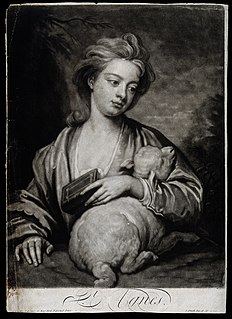
Mezzotint is a printmaking process of the intaglio family. It was the first tonal method to be used, enabling half-tones to be produced without using line- or dot-based techniques like hatching, cross-hatching or stipple. Mezzotint achieves tonality by roughening a metal plate with thousands of little dots made by a metal tool with small teeth, called a "rocker". In printing, the tiny pits in the plate retain the ink when the face of the plate is wiped clean. This technique can achieve a high level of quality and richness in the print.

Thomas Phillips RA was a leading English portrait and subject painter. He painted many of the great men of the day including scientists, artists, writers, poets and explorers.

Valentine Green was a British mezzotinter and print publisher. Green trained under Robert Hancock, a Worcester engraver, after which he moved to London and began working as a mezzotint engraver. He began to exhibit with the Incorporated Society of Artists from 1766, became a fellow a year later and a director in 1771. He was appointed mezzotint engraver to the King in 1773, and the following year was elected an associate engraver with the Royal Academy. Throughout the 1770s and 1780s, Green's engraving practice flourished. In the 1790s, however, several of his international speculations failed and in 1798 he was declared bankrupt. In 1805, he accepted the role of keeper of the British Institution, a post he held until his death.

John Raphael Smith was a British painter and mezzotinter. He was the son of Thomas Smith of Derby, the landscape painter, and father of John Rubens Smith, a painter who emigrated to the United States.
Joseph Grozer (1755–1799) was an English artist and printmaker. He resided at No 8, Castle Street, Leicester Square (1792-4) and published some of his prints himself.

Thomas Oldham Barlow was an English mezzotint engraver. His prints helped to popularise the works of painters like John Phillip and Sir John Everett Millais.

Thomas Goff Lupton was an English mezzotint engraver and artist, who engraved many works by J. M. W. Turner and other notable British painters of the 19th century. He also produced some pastels, exhibited at the Royal Academy. He played an important part in advancing the technical aspect of engraving by introducing soft steel plates.

Samuel William Reynolds was a mezzotint engraver, landscape painter and landscape gardener. Reynolds was a popular engraver in both Britain and France and there are over 400 examples of his work in the National Portrait Gallery, London.
William Oakley Burgess was an English mezzotint engraver.

Henry Meyer was an English portrait painter, more known as a stipple and mezzotint engraver.

John Smith was an English mezzotint engraver and print seller. Closely associated with the portrait painter Godfrey Kneller, Smith was one of leading exponents of the mezzotint medium during the late 17th and early 18th centuries, and was regarded among first English-born artists to receive international recognition, along the younger painter William Hogarth.

Jonathan Spilsbury (1737?–1812) was an English engraver, the brother of John Spilsbury, with whom he has sometimes been confused, and father of Maria Spilsbury.

William Say (1768–1834) was a British mezzotinter, born in Lakenham, Norfolk.
John James Halls (1776–1853) was an English painter.

James Ramsay (1789–1854) was a British portrait painter, working in oils.

William Dickinson (1746–1823) was an English mezzotint engraver.
Frederick Stacpoole was a British engraver, who produced reproductions of some of the most popular paintings of the Victorian period.
John Jones (c.1755–1797) was a British engraver.
Caroline Watson (1761?–1814) was an English stipple engraver.
John Lindsay Lucas (1807–1874) was an English portrait painter.












